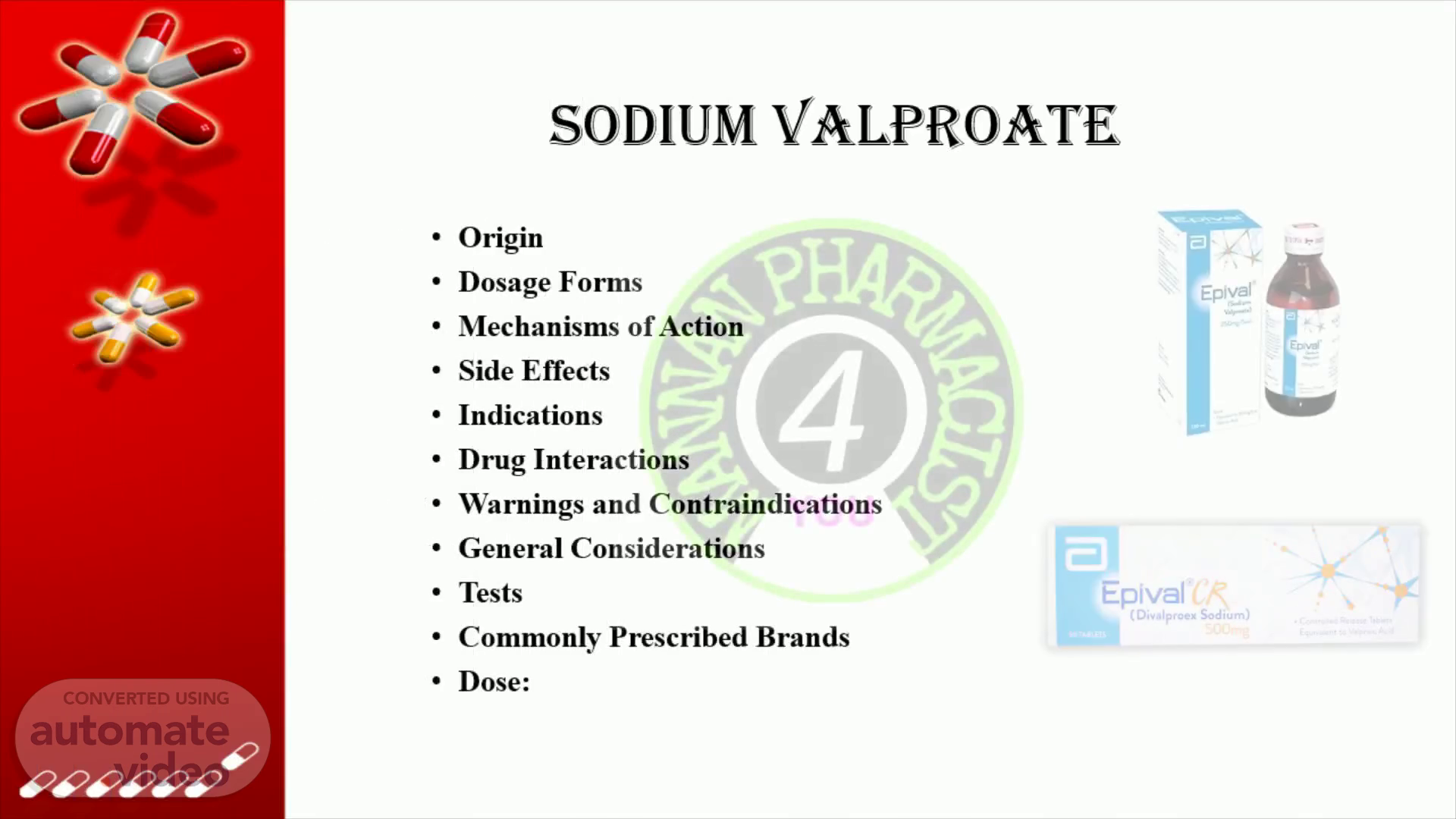Page 1 (0s)
Sodium Valproate. Origin Dosage Forms Mechanisms of Action Side Effects Indications Drug Interactions Warning s and Contraindications General Considerations Tests Commonly Prescribed Brands Dose:
Page 2 (15s)
Origin. The anticonvulsant properties of N- dipropylacetic acid (valproic acid) were discovered in 1967 by Meunier and Carroz . Valproic acid (VPA) is a branched short-chain fatty acid derived from naturally occurring valeric acid. VPA is used primarily in the treatment of epilepsy and seizures but is also used in migraine, bipolar, mood, anxiety, and psychiatric disorders..
Page 3 (36s)
Dosage Forms. It is available in the form of: Tablets Injection Syrups.
Page 4 (46s)
YOU. Mecha nisms of Action. The exact mode of action is unknown. It is said to cause anti-convulsant activity by increasing GABA levels & potentiation GABA effects in the brain, thereby blocking sodium & calcium channels and glutamate/NMDA receptors..
Page 5 (1m 2s)
Side Effects. Nausea Vomiting Diarrhea, Dyspepsia, Headache, Somnolence, Dizziness, Nystagmus, Tinnitus, Amblyopia, Diplopia, Asthenia, Alopecia, Increased Bleeding Time, Thrombocytopenia, Tremor..
Page 6 (1m 17s)
Indications. Sodium valproate is an anticonvulsant used to treat certain types of seizures (epilepsy)..
Page 7 (1m 28s)
Drug Interactions. Sodium Valproate has many Interactions but few I will discuss. 1. Don't use Aspirin may increase valproate concentrations. It May also interfere with valproate's metabolism; concomitant use should be avoided. 2. Don't use Benzodiazepines may cause CNS depression and there are possible pharmacokinetic interactions; concomitant use should be avoided. 3. Don't use Cimetidine, Erythromycin inhibits valproate's metabolism in the liver, leading to increased valproate concentrations; concomitant use should be avoided..
Page 8 (1m 52s)
Warning and Contraindications:. It is contraindicated in 'Patients with Haptic disease ''Pregnancy‘’ Patients with mitochondrial disorder '.
Page 9 (2m 3s)
General Considerations. Advice patient to take with food or with plenty of water. Advice patient to avoid alcohol intake. Advice patient to avoid activities requiring mental alertness and motor coordination. Advice patient to avoid abrupt drug withdrawal. Extended-release tablets are intended for once a day oral administration. When using delayed-release tablets, total daily doses in excess of 250 mg should be given in divided doses..
Page 10 (2m 26s)
Tests. The patients who use this medicine should perform the following tests: Serum drug concentration serum ammonia level liver function tests complete blood count.
Page 11 (2m 38s)
Commonly Prescribed Medicine And Dose. Tab. Epival 250, 500mg Inj. Epival 500mg Dose:750-2000mg in 2-4 divided doses.
Page 12 (2m 51s)
nox. Thanks For Watching Subscribe.
